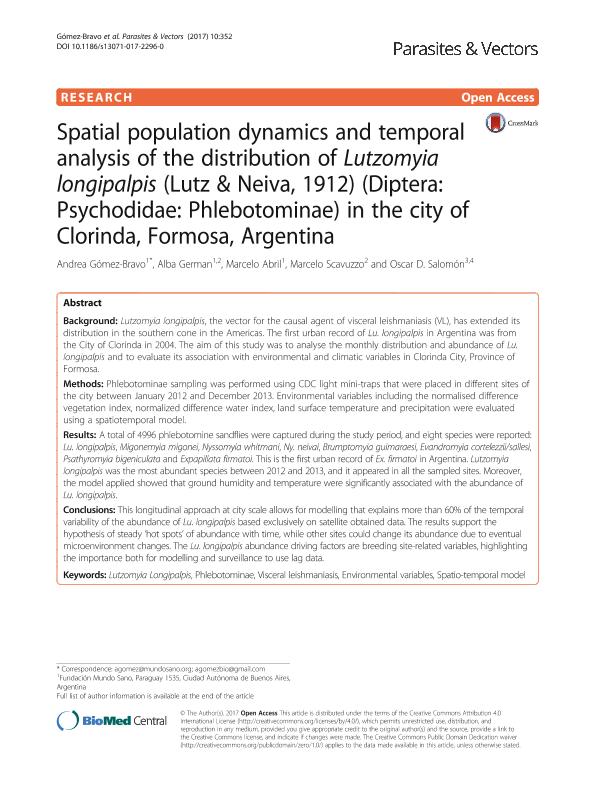Artículo
Spatial population dynamics and temporal analysis of the distribution of Lutzomyia longipalpis (Lutz & Neiva, 1912) (Diptera: Psychodidae: Phlebotominae) in the city of Clorinda, Formosa, Argentina
Fecha de publicación:
07/2017
Editorial:
BioMed Central
Revista:
Parasites and Vectors
ISSN:
1756-3305
e-ISSN:
1756-3305
Idioma:
Inglés
Tipo de recurso:
Artículo publicado
Clasificación temática:
Resumen
Background: Lutzomyia longipalpis, the vector for the causal agent of visceral leishmaniasis (VL), has extended itsdistribution in the southern cone in the Americas. The first urban record of Lu. longipalpis in Argentina was fromthe City of Clorinda in 2004. The aim of this study was to analyse the monthly distribution and abundance of Lu.longipalpis and to evaluate its association with environmental and climatic variables in Clorinda City, Province ofFormosa.Methods: Phlebotominae sampling was performed using CDC light mini-traps that were placed in different sites ofthe city between January 2012 and December 2013. Environmental variables including the normalised differencevegetation index, normalized difference water index, land surface temperature and precipitation were evaluatedusing a spatiotemporal model.Results: A total of 4996 phlebotomine sandflies were captured during the study period, and eight species were reported:Lu. longipalpis, Migonemyia migonei, Nyssomyia whitmani, Ny. neivai, Brumptomyia guimaraesi, Evandromyia cortelezzii/sallesi,Psathyromyia bigeniculata and Expapillata firmatoi. This is the first urban record of Ex. firmatoi in Argentina. Lutzomyialongipalpis was the most abundant species between 2012 and 2013, and it appeared in all the sampled sites. Moreover,the model applied showed that ground humidity and temperature were significantly associated with the abundance ofLu. longipalpis.Conclusions: This longitudinal approach at city scale allows for modelling that explains more than 60% of the temporalvariability of the abundance of Lu. longipalpis based exclusively on satellite obtained data. The results support thehypothesis of steady ?hot spots? of abundance with time, while other sites could change its abundance due to eventualmicroenvironment changes. The Lu. longipalpis abundance driving factors are breeding site-related variables, highlightingthe importance both for modelling and surveillance to use lag data
Archivos asociados
Licencia
Identificadores
Colecciones
Articulos(CCT - NORDESTE)
Articulos de CTRO.CIENTIFICO TECNOL.CONICET - NORDESTE
Articulos de CTRO.CIENTIFICO TECNOL.CONICET - NORDESTE
Citación
Gómez Bravo, Andrea; German, Alba; Abril, Marcelo; Scavuzzo, Carlos Marcelo; Salomón, Oscar Daniel; Spatial population dynamics and temporal analysis of the distribution of Lutzomyia longipalpis (Lutz & Neiva, 1912) (Diptera: Psychodidae: Phlebotominae) in the city of Clorinda, Formosa, Argentina; BioMed Central; Parasites and Vectors; 10; 1; 7-2017; 1-9;352
Compartir
Altmétricas




